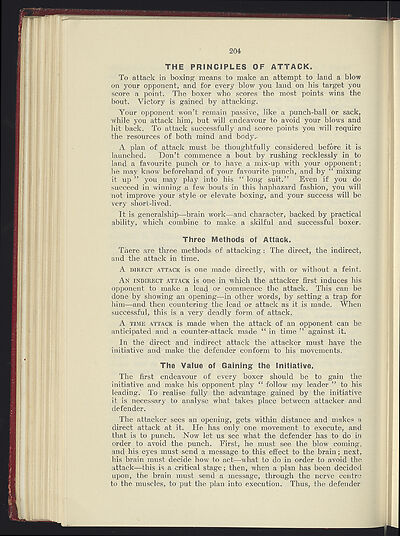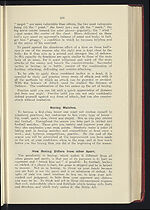1931
(216)
Download files
Complete book:
Individual page:
Thumbnail gallery: Grid view | List view

204
THE PRINCIPLES OF ATTACK.
To attack in boxing means to make an attempt to land a blow
on your opponent, and for every blow you land on his target you
score a point. The boxer who scores the most points wins the
bout. Victory is gained by attacking.
Your opponent won't remain passive, like a punch-ball or sack,
while you attack him, but will endeavour to avoid your blows and
hit back. To attack successfully and score points you will require
the resources of both mind and body..
A plan of attack must be thoughtfully considered before it is
launched. Don't commence a bout by rushing recklessly in to
land a favourite punch or to have a mix-up with your opponent;
lie may know beforehand of your favourite punch, and by " mixing
it up " you may play into his "long suit." Even if you do
succeed in winning a few bouts in this haphazard fashion, you will
not improve your style or elevate boxing, and your success will be
very short-lived.
It is generalship—brain work—and character, backed by practical
ability, which combine to make a skilful and successful boxer.
Three Methods of Attack.
There are three methods of attacking : The direct, the indirect,
and the attack in time.
A
DIRECT ATTACK
is one made directly, with or without a feint.
A
N INDIRECT ATTACK
is one in which the attacker first induces his
opponent to make a lead or commence the attack. This can be
done by showing an opening—in other words, by setting a trap for
him—and then countering the lead or attack as it is made. When
successful, this is a very deadly form of attack.
A
TInIE ATTACK
is made when the attack of an opponent can be
anticipated and a counter-attack made " in time " against it.
In the direct and indirect attack the attacker must have the
initiative and make the defender conform to his movements.
The Value of Gaining the Initiative.
The first endeavour of every boxer should be to gain the
initiative and make his opponent play " follow my leader " to his
leading: To realise fully the advantage gained by the initiative
it is necessary to analyse what takes place between attacker and
defender.
The attacker sees an opening, gets within distance and makes a.
direct attack at it. He has only one movement to execute, and
that is to punch. Now let us see what the defender has to do in
order to avoid the punch. First, he must see the blow coming,
and his eyes must send a message to this effect to the brain; next,
his brain must decide how to act—what to do in order to avoid the
attack—this is a critical stage; then, when a plan has been decided
upon, the brain must send a message, through the nerve centre
to the muscles, to put the plan into execution. Thus, the defender
THE PRINCIPLES OF ATTACK.
To attack in boxing means to make an attempt to land a blow
on your opponent, and for every blow you land on his target you
score a point. The boxer who scores the most points wins the
bout. Victory is gained by attacking.
Your opponent won't remain passive, like a punch-ball or sack,
while you attack him, but will endeavour to avoid your blows and
hit back. To attack successfully and score points you will require
the resources of both mind and body..
A plan of attack must be thoughtfully considered before it is
launched. Don't commence a bout by rushing recklessly in to
land a favourite punch or to have a mix-up with your opponent;
lie may know beforehand of your favourite punch, and by " mixing
it up " you may play into his "long suit." Even if you do
succeed in winning a few bouts in this haphazard fashion, you will
not improve your style or elevate boxing, and your success will be
very short-lived.
It is generalship—brain work—and character, backed by practical
ability, which combine to make a skilful and successful boxer.
Three Methods of Attack.
There are three methods of attacking : The direct, the indirect,
and the attack in time.
A
DIRECT ATTACK
is one made directly, with or without a feint.
A
N INDIRECT ATTACK
is one in which the attacker first induces his
opponent to make a lead or commence the attack. This can be
done by showing an opening—in other words, by setting a trap for
him—and then countering the lead or attack as it is made. When
successful, this is a very deadly form of attack.
A
TInIE ATTACK
is made when the attack of an opponent can be
anticipated and a counter-attack made " in time " against it.
In the direct and indirect attack the attacker must have the
initiative and make the defender conform to his movements.
The Value of Gaining the Initiative.
The first endeavour of every boxer should be to gain the
initiative and make his opponent play " follow my leader " to his
leading: To realise fully the advantage gained by the initiative
it is necessary to analyse what takes place between attacker and
defender.
The attacker sees an opening, gets within distance and makes a.
direct attack at it. He has only one movement to execute, and
that is to punch. Now let us see what the defender has to do in
order to avoid the punch. First, he must see the blow coming,
and his eyes must send a message to this effect to the brain; next,
his brain must decide how to act—what to do in order to avoid the
attack—this is a critical stage; then, when a plan has been decided
upon, the brain must send a message, through the nerve centre
to the muscles, to put the plan into execution. Thus, the defender
Set display mode to:
![]() Universal Viewer |
Universal Viewer | ![]() Mirador |
Large image | Transcription
Mirador |
Large image | Transcription
| Games and sports in the army > 1931 > (216) |
|---|
| Permanent URL | https://digital.nls.uk/248674183 |
|---|
| Description | 'Games and Sports in the Army' was an annual publication produced by the British War Office between the 1930s and 1960s. This included the Second World War. It outlines the rules and regulations for games and sports played by members of the armed forces. It features names and photographs of team members, and examples of contemporary advertising. |
|---|---|
| Shelfmark | GWB.52 |

